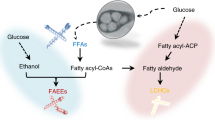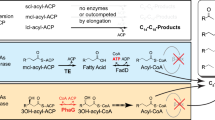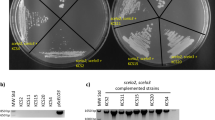Abstract
We report the production of two very long chain polyunsaturated fatty acids, arachidonic acid (AA) and eicosapentaenoic acid (EPA), in substantial quantities in a higher plant. This was achieved using genes encoding enzymes participating in the ω3/6 Δ8-desaturation biosynthetic pathways for the formation of C20 polyunsaturated fatty acids. Arabidopsis thaliana was transformed sequentially with genes encoding a Δ9-specific elongating activity from Isochrysis galbana, a Δ8-desaturase from Euglena gracilis and a Δ5-desaturase from Mortierella alpina. Instrumental in the successful reconstitution of these C20 polyunsaturated fatty acid biosynthetic pathways was the I. galbana C18-Δ9-elongating activity, which may bypass rate-limiting steps present in the conventional Δ6-desaturase/elongase pathways. The accumulation of EPA and AA in transgenic plants is a breakthrough in the search for alternative sustainable sources of fish oils.
This is a preview of subscription content, access via your institution
Access options
Subscribe to this journal
Receive 12 print issues and online access
$209.00 per year
only $17.42 per issue
Buy this article
- Purchase on Springer Link
- Instant access to full article PDF
Prices may be subject to local taxes which are calculated during checkout




Similar content being viewed by others
References
Carlson, S.E., Werkman, S.H., Peeples, J.M., Cooke, R.J. & Tolley, E.A. Arachidonic acid status correlates with the first year growth in preterm infants. Proc. Natl. Acad. Sci. USA 90, 1073–1077 (1993).
Gill, I. & Valivety, R. Polyunsaturated fatty acids, part 1: occurrence, biological activities and applications. Trends Biotechnol. 15, 401–409 (1997).
Crawford, M. Placental delivery of arachidonic acid and docosahexaenoic acids: implication for the lipid nutrition of preterm infants. Am. J. Clin. Nutr. 71, 275S–284S (2000).
Lauritzen, L., Hansen, H.S., Jurgensen, M.H. & Michaelsen, K.F. The essentiality of long chain n-3 fatty acids in relation to development and function of brain and retina. Prog. Lipid Res. 40, 1–94 (2001).
Thies, F. et al. Association of n-3 polyunsaturated fatty acids with stability of atherosclerotic plaques: a randomized controlled trial. Lancet 361, 477–485 (2003).
Kinsella, J.E., Lokesh, B., Broughton, S. & Whelan, J. Dietary polyunsaturated fatty acids and eicosanoids: potential effects on the modulaton of inflammatory and immune cells: an overview. Nutrition 6, 24–44 (1990).
Fievez, V., Dohme, F., Danneels, M., Raes, K. and Demeyer, D. Fish oils as potent rumen inhibitors and associated effects on rumen fermentation in vitro and in vivo. Anim. Feed Sci. Technol. 104, 41–58 (2003).
Yokoo, E.M. et al. (2003) Low level methylmercury exposure affects neuropsychological function in adults. Environmental Health: A Global Access Science Source 2, 1–11 (http://www.ehjournal.net/content/2/1/8) 2003.
Drexler, H. et al. Metabolic engineering of fatty acids for breeding of new oilseed crops: strategies, problems and first results. J. Plant Physiol. 160, 779–802 (2003).
Hites, R.A. et al. Global assessment of organic contamination in farmed salmon. Science 303, 226–229 (2004).
Yamazaki, K., Fujikawa, M., Hamazaki, T., Yano, S. & Shono, T. Comparison of the conversion rates of α-linolenic acid (18:3n-3) and stearidonic acid (18:4n-3) to longer polyunsaturated fatty acids in rats. Biochim. Biophys. Acta 1123, 18–26 (1992).
Sayanova, O. et al. Expression of a borage desaturase cDNA containing an N-terminal cytochrome b5 domain results in the accumulation of higher levels of Δ6-desaturated fatty acids in transgenic tobacco. Proc. Natl. Acad. Sci. USA 94, 4211–4216 (1997).
Cho, H.P., Nakamura, M.T. & Clarke, S.D. Cloning, expression, and nutrition regulation of the mammalian Δ6 desaturase. J. Biol. Chem. 274, 471–477 (1999).
Napier, J.A., Hey, S.J., Lacey, D.J. & Shewry, P.R. Identification of a Caenorhabditis elegans Δ6-fatty acid-desaturase by heterologous expression in Saccharomyces cerevisiae. Biochem. J. 330, 611–614 (1998).
Girke, T., Zähringer, U., Lerchl, J. & Heinz, E. Identification of a novel Δ6-acyl-group desaturase by targeted gene disruption in Physcomitrella patens. Plant J. 15, 39–48 (1998).
Sperling, P. et al. A bifunctional Δ6-fatty acyl acetylenase/desaturase from the moss Ceratodon purpureus. A new member of the cytochrome b5 superfamily. Eur. J. Biochem. 267, 3801–3811 (2000).
Huang, Y.S. et al. Cloning of delta12- and delta6-desaturases from Mortierella alpina and recombinant production of gamma-linolenic acid in Saccharomyces cerevisiae. Lipids 34, 649–659 (1999).
Sakuradani, E., Kobayashi, M. & Shimizu, S. Delta6-fatty acid desaturase from an arachidonic acid-producing Mortierella fungus. Gene cloning and its heterologous expression in a fungus, Aspergillus. Gene 238, 445–453 (1999).
Beaudoin, F. et al. Heterologous reconstitution in yeast of the polyunsaturated fatty acid biosynthetic pathway. Proc. Natl. Acad. Sci. USA 97, 6421–6426 (2000).
Parker-Barnes, J.M. et al. Identification and characterization of an enzyme involved in the elongation of n-6 and n-3 polyunsaturated fatty acids. Proc. Natl. Acad. Sci. USA 97, 8284–8289 (2000).
Zank, T.K. et al. Cloning and functional characterization of an enzyme involved in the elongation of Delta6-polyunsaturated fatty acids from the moss Physcomitrella patens. Plant J. 31, 255–268 (2002).
Cho, H.P., Nakamura, M.T. & Clarke, S.D. Cloning, expression, and fatty acid regulation of the human Δ5 desaturase. J. Biol. Chem. 274, 37335–37339 (1999).
Leonard, A.E. et al. cDNA cloning and characterization of a human Δ5-desaturase involved in the biosynthesis of arachidonic acid. Biochem. J. 347, 719–724 (2000).
Watts, J.L. & Browse, J. Isolation and characterization of a Δ5-fatty acid desaturase from Caenorhabditis elegans. Arch. Biochem. Biophys. 362, 175–182 (1999).
Michaelson, L.V. et al. Functional identification of a fatty acid Δ5-desaturase gene from Caenorhabditis elegans. FEBS Lett. 439, 215–218 (1998).
Michaelson, L.V., Lazarus, C.M., Griffiths, G., Napier, J.A. & Stobart, A.K. Isolation of a Δ5-fatty acid desaturase gene from Mortierella alpina. J. Biol. Chem. 273, 19055–19059 (1998).
Knutzon, D.S. et al. Identification of Δ5-desaturase from Mortierella alpina by heterologous expression in bakers' yeast and canola. J. Biol. Chem. 273, 29360–29366 (1998).
Qi, B. et al. Identification of a cDNA encoding a novel C18-Δ9-polyunsaturated fatty acid-specific elongating activity from the docosahexaenoic acid (DHA)-producing microalga, Isochrysis galbana. FEBS Lett. 510, 159–165 (2002).
Wallis and Browse. The Δ8-desaturase of Euglena gracilis: an alternate pathway for synthesis of 20-carbon polyunsaturated fatty acids. Arch. Biochem. Biophys. 365, 307–316 (1999).
Zhang, J.Y., Yu, Q.T., Liu, B.N. & Huang, Z.H. Chemical modification in mass spectrometry IV – 2-alkenyl-4,4-dimethyloxazolines as derivatives for the double bond location of long-chain olefinic acids. Biomed. Environ. Mass Spectrom. 15, 33–44 (1988).
Berdeaux, O. & Wolff, R.L. Gas-liquid chromatography-mass spectrometry of the 4,4-dimethyloxazoline derivatives of Δ5-unsaturated polymethylene-interrupted fatty acids from conifer seed oils. J. Am. Oil Chem. Soc. 73, 1323–1326 (1996).
Qi, B. et al. The variant 'his-box' of the C18-Δ9-PUFA-specific elongase IgASE1 from Isochrysis galbana is essential for optimum enzyme activity. FEBS Lett. 547, 137–139 (2003).
Larson, T.R. & Graham, I.A. Application of a new method for the sensitive detection and quantification of acyl-CoA esters in Arabidopsis thaliana seedlings and mature leaves. Biochem. Soc. Trans. 28, 575–577 (2000).
Domergue, F. et al. Acyl carriers used as substrates by the desaturases and elongases involved in very long-chain polyunsaturated fatty acids biosynthesis reconstituted in yeast. J. Biol. Chem. 278, 35115–35126 (2003).
Stymne, S. & Stobart, A.K. Evidence for the reversibility of the acyl-CoA: lysophosphatidylcholine acyltransferase in microsomal preparations from developing safflower cotyledons and rat liver. Biochem. J. 223, 305–314 (1984).
Stymne, S. & Stobart, A.K. Triglycerol Biosynthesis. in The Biochemistry of Plants: A Comprehensive Treatise (ed. Stumpf, P.K.) 175–214 (Academic Press, NY, 1988).
Millar, A.A., Wrischer, M. & Kunst, L. Accumulation of very-long-chain fatty acids in membrane glycerolipids is associated with dramatic alterations in plant morphology. Plant Cell 10, 1889–1902 (1998).
Qi, B. et al. Expression of the Isochrysis C18-Δ9 polyunsaturated fatty acid specific elongase component alters Arabidopsis glycerolipid profiles. Plant Physiol. (in the press) (2004).
Xiang, C., Han, P., Lutziger, I., Wang, K. & Oliver, D.J. A mini binary vector series for plant transformation. Plant Mol. Biol. 40, 711–717 (1999).
McCormac, A.C., Elliott, M.C. & Chen, D.-F. pBECKS. A flexible series of binary vectors for Agrobacterium-mediated plant transformation. Mol. Biotechnol. 8, 199–213 (1997).
Clough, S.J. & Bent, A.F. Floral dip: a simplified method for Agrobacterium-mediated transformation of Arabidopsis thaliana. Plant J. 16, 735–743 (1998).
Browse, J., McCourt, J. & Somerville, C.R. Fatty acid composition of leaf lipids determined after combined digestion and fatty acid methyl ester formation from fresh tissue. Anal. Biochem. 152, 141–145 (1986).
Acknowledgements
The authors gratefully acknowledge financial support from BASF Plant Sciences GmbH, Germany, and the Scottish Executive Environment and Rural Affairs Department. Long Ashton Research Station (1903–2003) and Rothamsted Research receive grant in aid from the Biotechnology and Biological Sciences Research Council (BBSRC) UK.
Author information
Authors and Affiliations
Corresponding author
Ethics declarations
Competing interests
The research reported here was funded in part by BASF BmbH, Ludwigshafen, Germany.
Rights and permissions
About this article
Cite this article
Qi, B., Fraser, T., Mugford, S. et al. Production of very long chain polyunsaturated omega-3 and omega-6 fatty acids in plants. Nat Biotechnol 22, 739–745 (2004). https://doi.org/10.1038/nbt972
Received:
Accepted:
Published:
Issue Date:
DOI: https://doi.org/10.1038/nbt972
This article is cited by
-
Dietary Polyunsaturated Fatty Acids (PUFAs): Uses and Potential Health Benefits
Current Nutrition Reports (2021)
-
Effects of the intensification of soybean defects: consequences on the physicochemical, technological, protein and oil properties
European Food Research and Technology (2021)
-
Systems approach to quantify the global omega-3 fatty acid cycle
Nature Food (2020)
-
Endoplasmic reticulum retention signaling and transmembrane channel proteins predicted for oilseed ω3 fatty acid desaturase 3 (FAD3) genes
Functional & Integrative Genomics (2020)
-
Identification and Functional Characterization of Two Novel Fatty Acid Genes from Marine Microalgae for Eicosapentaenoic Acid Production
Applied Biochemistry and Biotechnology (2020)



